Read more about OPVCs in the Research Perspective: G. Balasubramanian et al., Computing in Science & Engineering 23, 48-55 (2021).
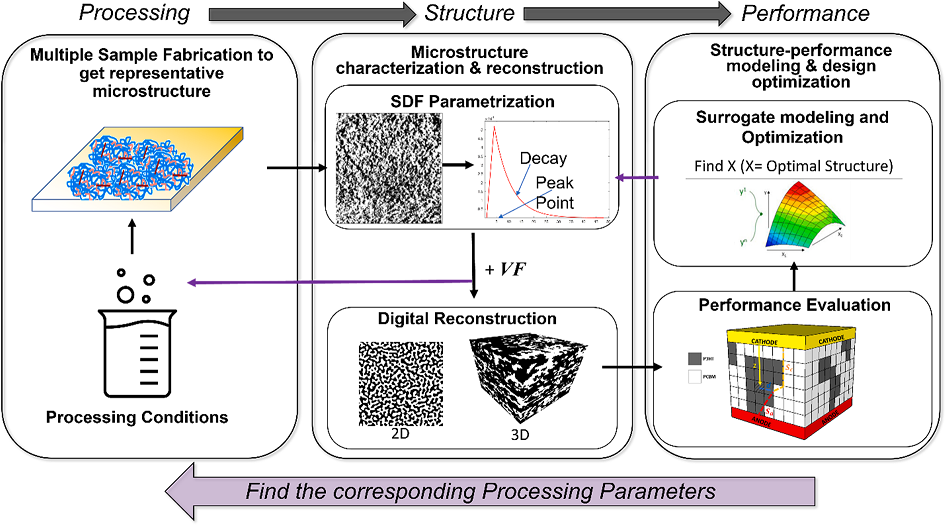
|
Designing active layer of organic solar cells using multi-fidelity molecular simulations and spectral density functionMolecular dynamics simulations have shown substantial promise in the design of organic photovoltaic cells (OPVC). Despite their potential, the utility of molecular dynamics simulations when designing an OPVC is often limited due to their considerable computational cost and their limited prediction accuracy. To address these challenges, we introduce a three-step multi-fidelity design framework that enables a designer to efficiently explore the space of admissible processing conditions, using coarse-grained molecular dynamics (CGMD) simulations, to identify the optimal OPVC design. Using a novel spectral density based approach to reconstruct microstructures of variable size, the framework is able to sequentially search for the globally optimal microstructure using a low-fidelity CGMD simulation with a smaller window size, followed by the optimization of the processing conditions using the high-fidelity simulation. The division in two steps and two fidelities enables the optimization of CGMD simulations at previously intractable lengths and timescales. We validate our results by demonstrating that the CGMD model predictions are consistent with physical experiments reported in the literature and corroborate that the computational complexity is reduced by one order of magnitude. Read more: Computational Materials Science 211, 111491 (2022). |
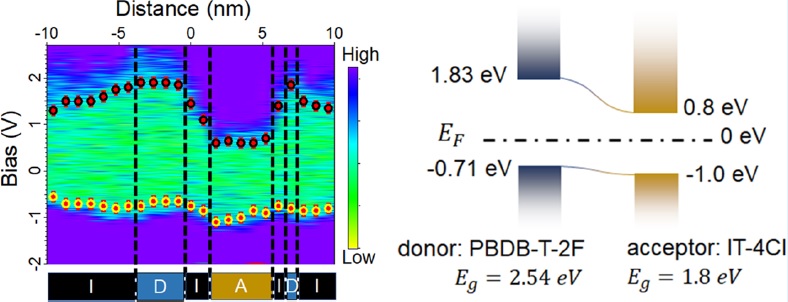
|
Direct Observations of Uniform Bulk Heterojunctions and the Energy Level Alignments in Nonfullerene Organic Photovoltaic Active LayersState-of-the-art organic photovoltaic (OPV) cells rely on the engineering of the energy levels of the organic molecules as well as the bulk-heterojunction nanomorphology to achieve high performance. However, both are difficult to measure inside the active layer where the electron donor and acceptor molecules are mingled. While the energy level alignments of the lowest unoccupied molecular orbital (LUMO) and highest occupied molecular orbital (HOMO) between the electron donors and acceptors may be altered in the mixed active layer compared to their pure forms, the nanomorphology of the donor and acceptor molecular domains is mostly studied in indirect means. Here, we present the direct observations of the nanomorphology of the molecular domains as well as the energy level alignments in the active layer of a nonfullerene-based OPV (donor: PBDB-T-2F and acceptor: IT-4Cl) using cross-sectional scanning tunneling microscopy and spectroscopy (XSTM/S). It is revealed that (1) the bulk-heterojunction (BHJ) structures are homogeneous and uniform throughout the ~1.2 μm thick active layer; (2) the energy alignments between the donor-rich and acceptor-rich domains are directly observed; (3) there exist the intermixing domains at the boundaries of the donor-rich and acceptor-rich domains with thickness in the nm scale; (4) the exciton binding energies in PBDB-T-2F and IT-4Cl are estimated to be 0.74 and 0.32 eV, respectively; and (5) there is an ~0.7 V loss in the open circuit voltage. The results provide a nanoscale understanding of the OPV active layers to guide further improvement of the OPV performance. Read more: ACS Appl. Mater. Interfaces 13, 56430-56437 (2021). |
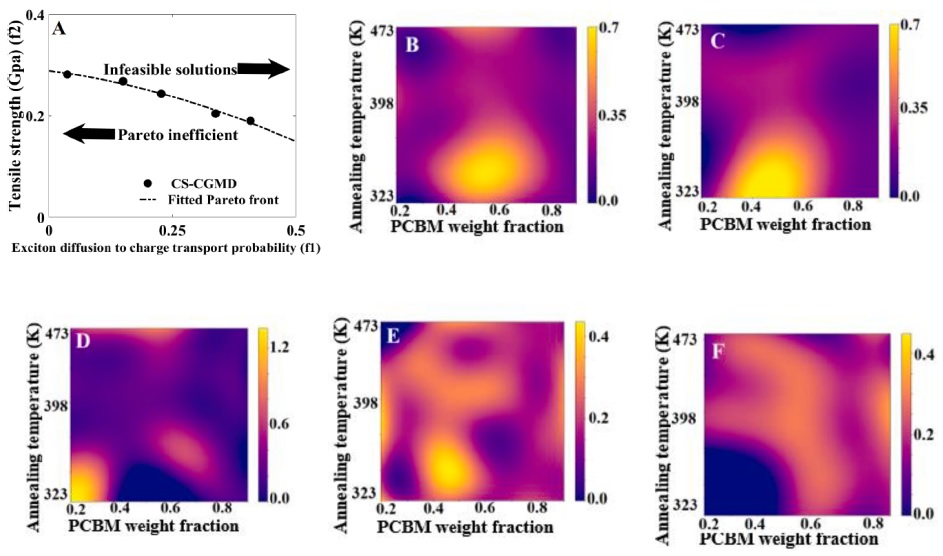
|
Machine learned metaheuristic optimization of the bulk heterojunction morphology in P3HT:PCBM thin filmsWe discuss results from a machine learned (ML) metaheuristic cuckoo search (CS) optimization technique that is coupled with coarse-grained molecular dynamics (CGMD) simulations to solve a materials and processing design problem for organic photovoltaic (OPV) devices. The method is employed to optimize the composition of donor and acceptor materials, and the thermal annealing temperature during the morphological evolution of a polymer blend active layer composed of poly-(3-hexylthiophene) (P3HT) and phenyl-C61-butyric acid methyl ester (PCBM), for an increased power conversion efficiency (PCE). The optimal solutions, which are in qualitative agreement with earlier experiments, identify correlation between the design variables that contributes to an enhanced material performance. The framework is extended to multi-objective design (MOCS-CGMD) to attain a Pareto optimality for the blend morphology, and enhance concurrently the exciton diffusion to charge transport probability and the ultimate tensile strength of the material. The predictions reveal that a higher annealing temperature enhances the exciton diffusion to charge transport probability, while a PCBM weight fraction between 0.4 and 0.6 increases the tensile strength of the underlying blend morphology. Read more: J. Munshi et al., Comp. Mater. Sci. 187, 110119 (2021). |
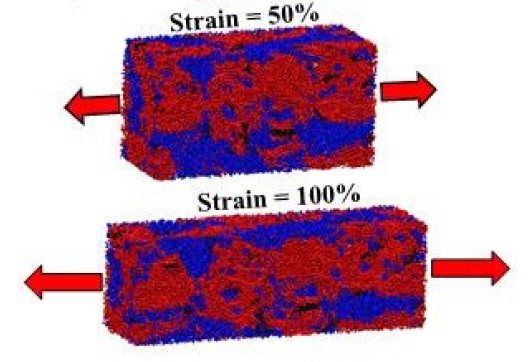
|
Elasto-morphology of P3HT:PCBM Bulk Heterojunction Organic Solar CellsPredicting the mechanical properties of organic semiconductors is important to employ these materials in flexible electronics applications. For instance, knowledge of the mechanical and thermal stability of thin film organic solar cells (OSCs) is critical for roll-to-roll production of photovoltaic devices and its use under various operating conditions. We examine the thermal and elasto-mechanical properties of conjugated donor polymer poly-(3-hexylthiophene) (P3HT) and interpenetrating mixtures of P3HT and phenyl-C61-butyric acid methyl ester (PCBM) bulk heterojunction (BHJ) active layers under an applied unidirectional tensile deformation using coarse-grained molecular dynamics (CGMD) simulations. The predictions are validated against previous experimental reports as well as with earlier modeling results derived using different intermolecular forcefields. Our results reveal that PCBM molecules behave as anti-plasticizers when mixed with P3HT and tend to increase the tensile modulus and glass transition temperature, while decreasing the crack-onset strain relative to pure P3HT. The variations in the mechanical properties with composition of the BHJ active layer suggest that in presence of small oligomers as additives in the BHJ, P3HT:PCBM mixture resists the anti-plasticizing effect of PCBM molecules due to low tensile modulus of the short polymer chains. Read more: J. Munshi et al., Soft Matter 16, 6743-6751(2020). |
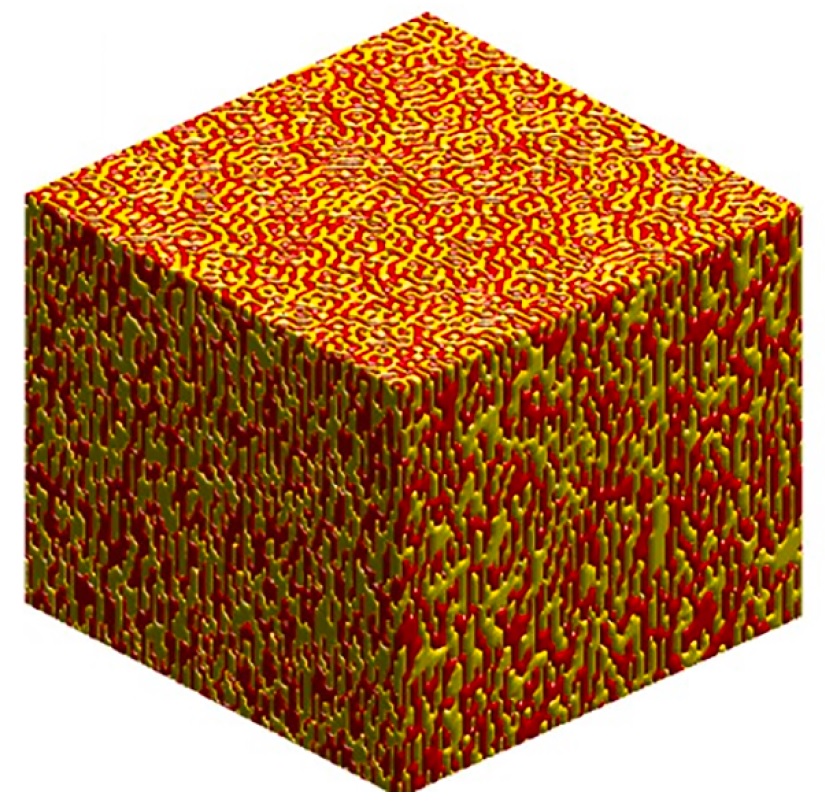
|
A Designing for Anisotropic Microstructures with Spectral Density FunctionOrganic photovoltaic cells (OPVCs) has been studied for decades. The efforts of exploring synthesis parameters have been carried out by trials and error. Recent years, the spectral density function (SDF) method has been utilized to be applied into OPVC design problems. While most prepared OPVC devices possess the isotropic bulkheterojunction structures in the photo-active layers, the traditional SDF design method was also performed in isotropic fashion. In our recent work, the electric field treatment during annealing process makes the molecular domains elongated in 10-20 nm scale, becoming anisotropic bulkheterojunction structure. Here, it is demonstrated that the anisotropic microstructural SDF can also be used in designing problems. Read more: A. Iyer et al., Comp. Mater. Sci. 179, 109559 (2020). |
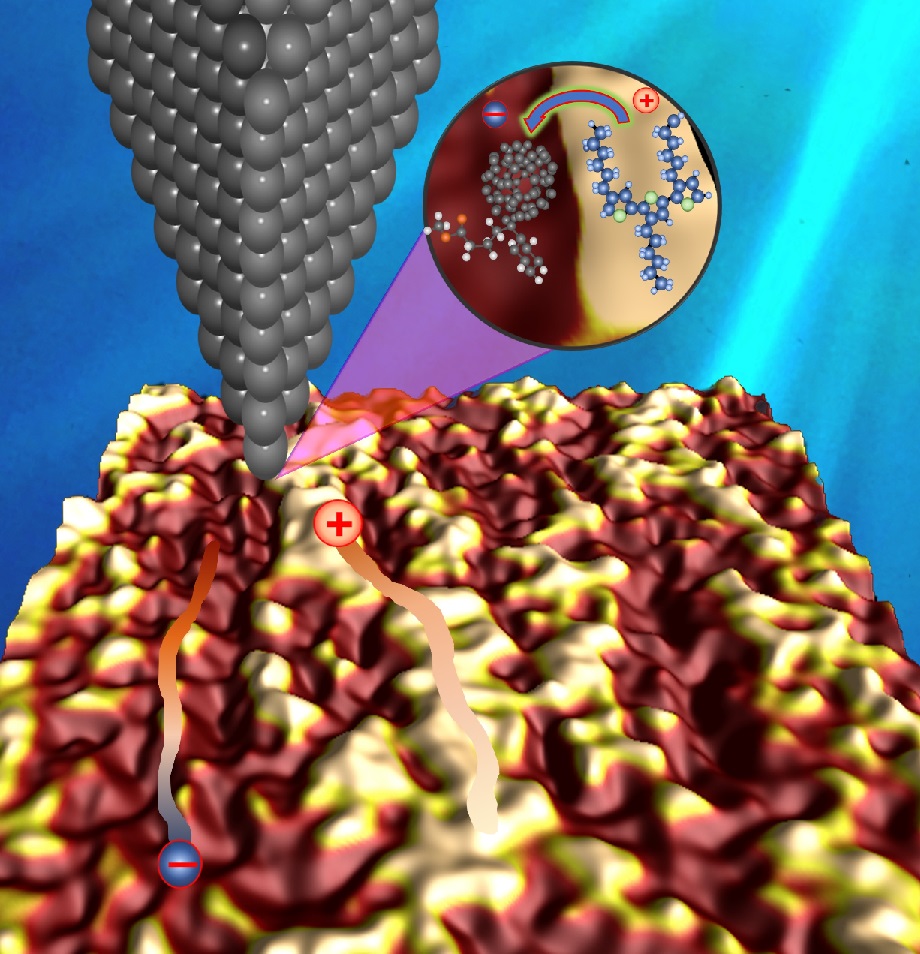
|
Molecular Domains in Organic Solar Cell Active Layers found Elongated and more Intermixed upon Electric Field TreatmentIn organic photovoltaics cells (OPVCs), the electronic properties and the quasi-random nanostructures of the molecular domains are the main factors impact on the cell performance. Recently, it was reported that upon the application of electric field treatment during device fabrications, the performance improved slightly. It was argued that the better crystallinity of P3HT, the polar molecule in the P3HT/PCBM combination, is the key to facilitate the charge mobility and hence better cell performance. In this work, by utilizing the cross-sectional scanning tunneling microscopy and spectroscopy (XSTM/S), it is revealed that the electric-field-assisted annealing has two significant effects on the OPVCs active layers: (1) the P3HT-rich domains formed elongated shape with the orientation close to the direction of the external electric field; and (2) the molecular intermixing is more severe, resulting in lower band gaps in the donor and acceptor molecular domains. The later effect has negative effect on exciton charge separation at the domain boundaries; while the former effect is beneficial to the charge diffusion toward electrodes after the charge separation. These results point out the competing factors and explain why the electric field treatments only have moderate improvement in the OPVC performance. Read more: R. Dulal et al., ACS Appl. Poly. Mater. 2, 335-341 (2020). |
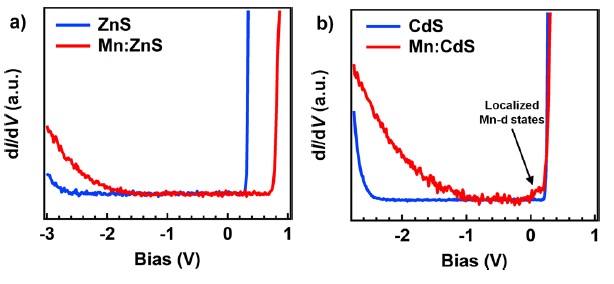
|
Influence of the Mn Doping on the Electronic and Magnetic Properties of CdS and ZnS Quantum DotsDoping semiconductors with transition metal elements may change the physical properties of the host materials. In a sense, the dopant can provide electron or hole doping. Also, if the transition metal has magnetic moment, it can also affect the magnetic properties. Here, we study the Mn doping in the CdS and ZnS semiconductors and revealed that the Mn doping has complex influence on the physical properties in CdS and ZnS by different mechanism. Ridig band shifting was observed in ZnS while it is not the case for CdS. Read more: A. J. Yost et al., J. Phys. Chem. C 123, 24890-24898 (2019). |
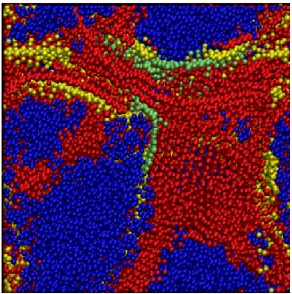
|
Effects of P3HT polydispersity on the P3HT:PCBM Bulk-Heterojunction MorphologyIn the P3HT:PCBM organic solar cells, various factors have been identified to influence the performance of the solar cells. All of the understanding was based on the Bulk-heterojunction architecture in the active layer. Polydispersity, the level of dispersing polymerization of P3HT, has not been explored. This ia mainly due to that in experiment, the polydispersity cannot be well controlled. To address this issue, the molecular dynamics simulation is used to reveal the effects of the polymerization of P3HT on the morphology of the P3HT:PCBM active layer. The results affirm that polydispersity is beneficial for charge separation as the interfacial area is observed to increase with higher dispersity. Most importantly, these results point out that the consideration of polydispersity should be considered in computational studies of polymer-based OPVCs. Also this may encourage experimentalists to consider ways of controlling the polydispersity for better OPVC performance. Read more: J. Munshi et al., J. Polym. Sci. Pol. Phys. 57, 895-903 (2019). |
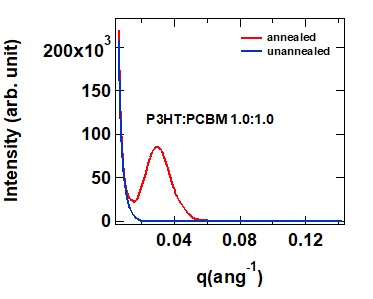
|
Solution Processing Dependent Bulk Heterojunction Nanomorphology of P3HT/PCBM Thin Films - CGMD Simulation and Diffraction ExperimentsP3HT (poly-(3-hexyl-thiophene)) and PCBM (phenyl-C61-butyric acid methyl ester) are among the most studied semiconductor organic molecule combinations for organic photovoltaics. Bulk heterojunction (BHJ) architecture of P3HT: PCBM active layer is found to have high efficiency due to its quasi random nanomorphology is beneficial for the short exciton mean free path. To understand the evolution of the nanomorphology of P3HT: PCBM active layer due to the solution processes, we study the bulk heterojunction focusing on the impacts of the process parameters, such as the P3HT/PCBM weight ratio, P3HT degree of polymerization (DOP), thermal annealing and pre-heating, using coarse-grained molecular dynamics (CGMD) simulations followed by the validation with the x-ray diffraction (XRD) and the small angle x-ray scattering (SAXS). The results showed that the annealing of the solvent-free P3HT/PCBM mixture (after solvent molecules are evaporated) enhances the intermixing phases for 1:1 weight ratio. In addition, the annealing effects are found to be predominant for shorter polymer chains compared to the loner ones. Read more: J. Munshi et al., ACS Appl. Mater. Interfaces 11, 17056-17067 (2019). |
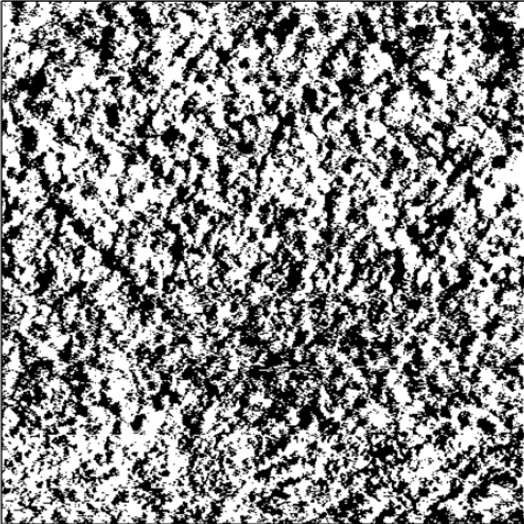
|
Spectral Density Function description of organic solar cell bulkheterojunctionsState-of-the-art organic photovoltaic cells (OPVCs) work with bulkheterojunction, a structure possesss quasi-random structures. There are two major issues in studying the bulkheterojunction in OPVCs: (1) measurements; and (2) quantifying the quasi-random structure. Since the two organic molecules (electron donors and acceptors) are mostly composed of carbon, hydrogen and some regular organic molecule elements, they are having almost the same contrast seen in transmission electron microscopy (TEM). Atomic force microscopy (AFM) also cannot distinguish the two different molecules. In this study, the two molecules are distinguished by using scanning tunneling microscopy and spectroscopy by the ability of measuring molecular orbitals provided by STM. Furthermore, the revealed donor and acceptor domains were analyzed by spectral density function (SDF) method. Combining with the designing algorithm, exciton and charge model, these information can produce meaningful guidance for the optimal performance for OPVCs. Read more: U. F. Ghumman et al., J. Mech. Design 140, 111408 (2018). |
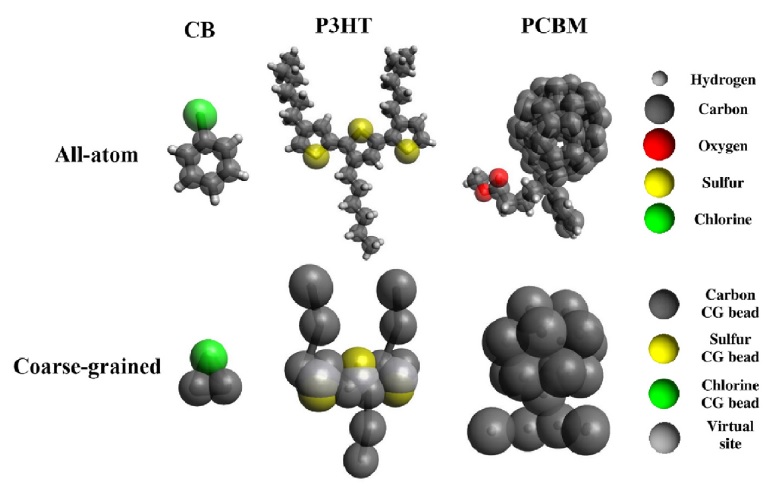
|
Coarse-grained molecular dynamics (CGMD) simulation study on P3HT/PCBM organic solar cell active layerOne important approach to study organic solar cell active layers is by simulation. For questions regarding how the two types of molecules mixed in the active layer, molecular dynamics (MD) simulation is a good approach. However, since the molecules are large and the quantities of the molecules are vast, simplification of the molecules with coarse-grained spheres show benefit for the research. In this work, the CGMD is utilized to study how the synthesis processing affect the nanostructure mixing in the P3HT/PCBM active layers. Also, the length of the P3HT polymer chain and the P3HT/PCBM weight ratio may affect the miscibility and molecule domain sizes. Read more: J. Munshi et al., Comp. Mater. Sci. 155, 112 (2018). |
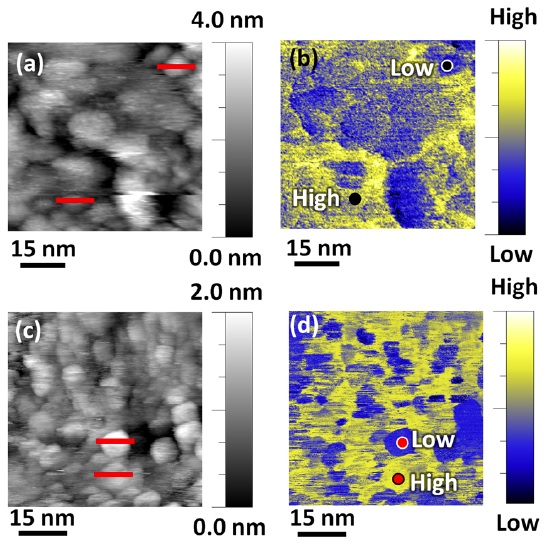
|
Mn dopant locations affect the sp-d hybridization strengthDilute magnetic semiconductors (DMS) have been studied for decade owing to its attractive properties of magnetism in semiconductors. Typically, DMS is achieved by doping semiconductors with transition elements, such as Mn. The sp-d hybridization between the sp band edge states of the semiconductors and the electrons in the d orbitals in the transition elements strongly influence the DMS properties. The DMS is well studied in bulk or thin film forms while the quantum dot (QD) form of DMS is considered very difficult. This is mainly due to the so-called "self-purification" process, in which the dopants tend to aggregate at the surfaces of the QDs. Despite the difficulty, many researchers have reported successful synthesis, the change of the physical properties, and the applications of the DMS QDs. However, so far, though mentioned, it is rarely studied that the location effects of the transition element dopants on the physical proeprties of host semiconducting QDs. In this study, we utilized STM/S to study PbS and Mn:PbS QDs synthesized by pulsed laser deposition methods. Combining results from various measurements and density functional theory calculation, we revealed that the Mn dopant locations may affect the sp-d hybridization strength in the PbS QDs and manifest itself as different level of bandgap widening. Read more: A. Yost et al., Appl. Phys. Lett. 111, 233101 (2017). |
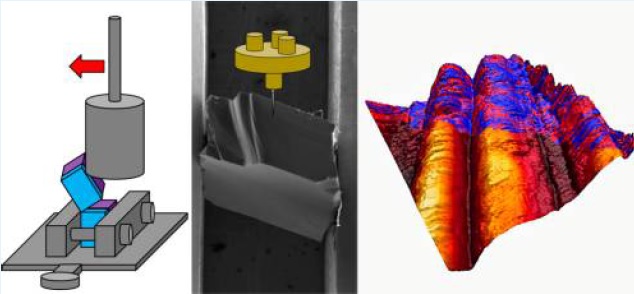
|
Nano-Scale Electronic Phase Separation in Organometallic Halide Perovskite MaterialsIn recent years, organometallic halide perovskite (OHP) materials have drawn plenty of attention in photovoltaic applications. Starting in year 2009 with a moderate solar cell power conversion efficiency (PCE) of ~3 % to the outstanding ~22 % PCE in year 2016. Over the past few years, it has been reported that the OHP materials, in various combination of cations/anions, exhibit extraordinary long exiton lifetime and mean free path, echoing with the reported high PCE. It is still mysterious why this type of materials could host long-lived excitons and conduct both electrons and holes pretty well before the charge collection at electrodes. An interesting trend about this type of materials and the solar cell performance was noticed by many researchers: high PCE OHP based solar cells are typically made with mixed cations or anions. To address this trend, we recently utilized scanning tunneling microscopy and spectroscopy (STM/S) to study CH3NH3PbI3-xClx thin films in cross-sectional geometry. We revealed, of first time, the existence of two distinct nano-scale electronic phase separation. The unprecedented discovery was only possible due to the choice of the STM/S technique, which has superior spatial resolution with capability of probing electronic properties that are needed to visualize this nano-scale electronic separation. We believe this observed nano-scale electronic phase separation will have profound influences on the excitons and charges dynamics in this type of materials. Further study is planned toward this direction. Read more: A. Yost et al., ACS Appl. Mater. & Interfaces 8, 29110-29116 (2016). |
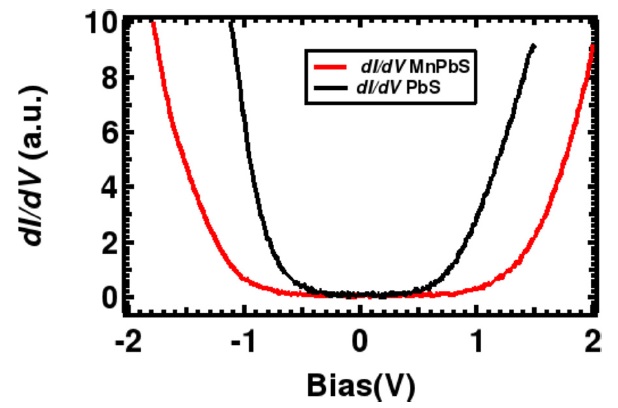
|
Mn Dopint Effects in PbS Quantum Dots for Applications in Quantum Dot Sensitized Solar CellsSolar cell applications have been thought as one of the major renewable energy resources in the future. Many types of solar cell materials have been studied to achieve the goals of large scale utilization. Among them, quantum dot sensitized solar cells (QDSSCs) are one of the most applicable cells. To further increase the efficiency of the QDSSCs, methods to extend the lifetime of the short lived excitons created in the QDs are the key. Here, we studied the magnetic element, Mn, doping effects into the semiconducting PbS QDs on the QDSSC applications. In this work, the Mn doped PbS QDs were deposited onto Zn2SnO4 (ZTO) nanowires (NWs), which are served as semiconducting electrodes to cllect the electrons injected from the QDs. It is found that the Mn doping widened the energy band gaps in PbS QDs, and most importantly, the Mn element on the surfaces of PbS QDs in contact with ZTO NWs lowered the energy barrier for electron injection from PbS QDs to the ZTO NWs. Due to the presence of the interfacial Mn atoms, the incident photon-to-current efficiency (IPCE) increased up to 700 % (with an average 300 % enhancement). This discovered enhancement mechanism may be a new way of engineering QDSSCs for further improvements. Read more: G. Rimal et al., Appl. Phys. Lett. 109, 103901 (2016). |

